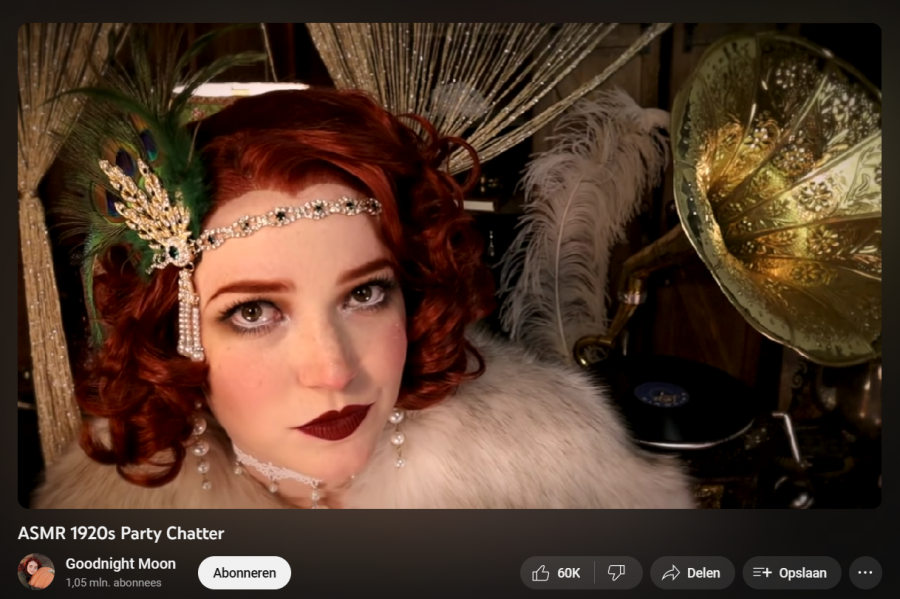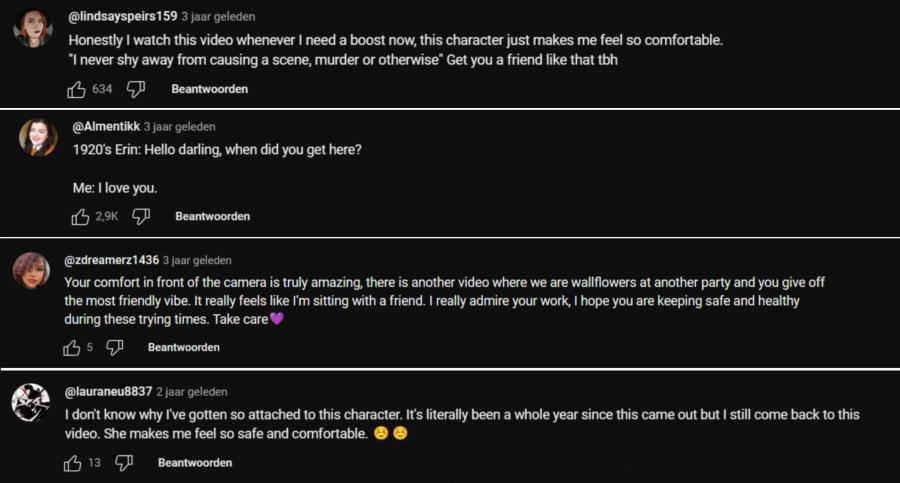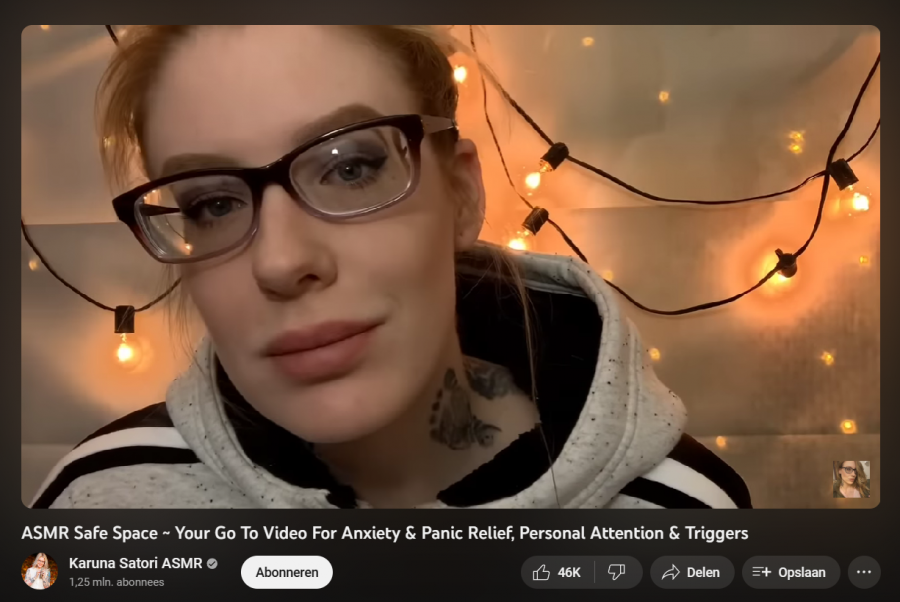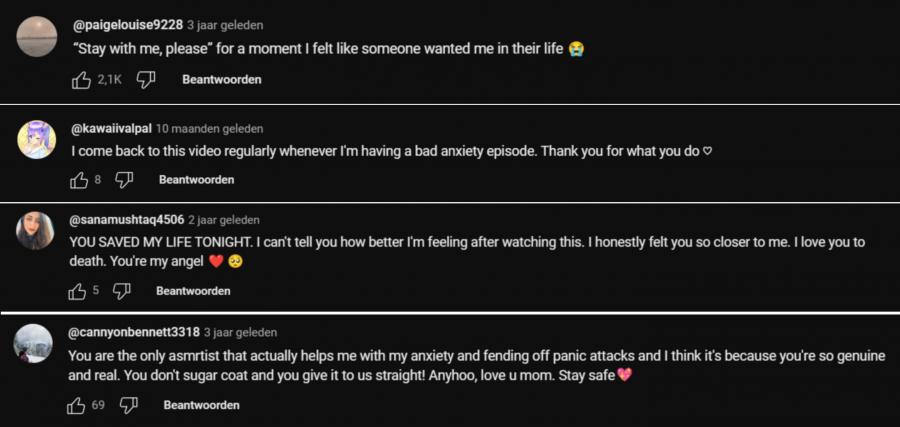
'I love you and I care about you’: How ASMR content creators establish parasocial relationships with their viewers
One of the various types of content available to us on the internet is Autonomous Sensory Meridian Response videos or ASMR videos for short. Although ASMR "first emerged online as a video phenomenon in 2007," it is still becoming more and more popular on websites like TikTok and YouTube (Klausen, 2019, p. 89).
In this essay, I concentrate on the parasocial interactions that these ASMR video producers have with their audience. I begin by giving some background on the ASMR phenomena and ASMR videos. Then, utilising works by Horton & Wohl, I define a parasocial connection. After that, I analyse several ASMR videos with an emphasis on how ASMR producers create this parasocial bond with their viewers. I then quickly wrap up the paper.
What is ASMR?
Autonomous Sensory Meridian Response, usually referred to as ASMR, is a ‘sensory phenomenon, in which individuals experience a tingling, static-like sensation across the scalp, back of the neck and at times further areas in response to specific triggering audio and visual stimuli’ (Barrett & Davis, 2015, p. 1).
This sensation, often accompanied by emotions of relaxation and peace, is involuntary, atypical, non-medical, and harmless (Mahady, 2023, p. 2). The stimuli that are used to elicit ASMR are referred to as 'triggers' (p. 2). ASMR, a sensation characterized by tingling and relaxation, can be triggered not only in physical settings but also through specific media consumption. This explains why a significant portion of the community gathers on online platforms such as YouTube (Barrett et al., 2017, p.1).
ASMR videos emerged online in 2007 (Klausen, 2019, p. 89) and persist today in both traditional and short, vertical formats. The use of specialized recording equipment like binaural microphones enables the creation of immersive audio experiences (Klausen, 2019, p. 91). Those who produce content aimed at eliciting these 'tingles' are commonly known as ASMRtists (p. 88).
Some of these ASMRtists prefer to create sound assortment videos, while others focus on role-plays (p. 88). However, ASMR videos are not necessarily limited to these two genres. A YouTube search also reveals the existence of content such as gaming ASMR videos, show-and-tell ASMR videos, ASMR mukbangs, and tarot readings in ASMR format. Mahady et al. (2023, p. 11) mention that even intimate and sexual content can function as ASMR content when adopted appropriately.
Viewers usually seek out ASMR content as ‘an opportunity for relaxation’, or they use the content as a tool to help them sleep or deal with stress (Barrett & Davis, 2015, p. 5). Hence, the most common time for people to consume ASMR is before bed, or during the day in their free time (p. 6). Barrett & Davis found that the consumption of ASMR can have a positive effect on one’s mood, even if one does not experience tingles (p. 7 & p. 11).
The effect of ASMR "steadily decreases over several hours" (p. 7). However, its positive impact isn't universal, as some individuals may be uncertain if it affects their mood or feel no change at all (p. 7). According to Barrett & Davis (2015, p. 11), their research suggests that ASMR content consumption may be particularly beneficial for those with moderate-to-severe depression, as they reported feeling more uplifted compared to those without depression. Additionally, individuals with chronic pain symptoms noted a noticeable decrease in discomfort for a few hours post-ASMR session, indicating potential benefits for this group as well (p. 11).
The majority of ASMR triggers used are auditory, although they can also be tactile, visual, or emotional: the auditory triggers are often ‘low frequency, gentle and repetitive’, and visual triggers are ‘slow and repetitive which often elicit[s] a sense of touch’ (Mahady, 2023, p.2).
Some ASMR triggers deviate from typical characteristics by featuring high-frequency sounds or lacking slow movements. However, they still evoke aesthetic appreciation due to their visually appealing presentation and focus on "visual and simulated tactile stimulation" (p. 5).
Examples include videos showcasing systematic object cutting or popping bubble wrap (p. 5). Barrett and Davis (2015, p. 6) identified whispering, personal attention, crisp sounds, and slow movements as some of the most popular triggers in their research. However, these stimuli aren't universally perceived as relaxing, as individual experiences vary. The reasons for such drastic differences in reactions to the same stimulus remain unclear (Barrett et al., 2017, p. 2).
Parasocial relationships
The concept of parasocial relationships was introduced by Horton & Wohl back in 1956, in the article Mass Communication and Para-Social Interaction. They defined it as a ‘simulacrum of conversational give and take’ whereby the audience tends to make the response more anticipated as the performer ‘seems to adjust his performance to the supposed response of the audience’ more (Horton & Wohl, 1956, p. 215).
To some degree, the persona the performer displays is a manufactured façade that has little in common with the self (p. 226). Whether they portray a fictional character or themself, the ‘actor’ usually interacts with the audience by facing the spectator and directly addressing them, as if the actor and the spectator were having a private conversation (p. 215). The actor can exploit technical tools to create such an illusion of intimacy for the audience (p. 219).
As the persona's appearance becomes a "regular and dependable event" in the viewer's daily life, a sense of familiarity with the persona develops (p. 216), even though there's a lack of effective reciprocity in this relationship (p. 215). This parasocial relationship offers comfort to the audience as it emphasizes the values of friendship and intimacy, providing an escape. In this imaginary space, audience members can explore and assume roles they may not have the chance to in their everyday lives (p. 222 & 223).
The social environment provided by ASMR reflects and reinforces common assumptions and knowledge about basic group interaction and sociability (p. 223). When the parasocial relationship serves as a substitute rather than complementing normal social life, it's termed "extreme para-sociability," compensating for the absence of reciprocation-based social relationships (p. 223).
In such cases, the parasocial relationship might be able to provide an escape from an unsatisfying reality, and the ‘blatant reassurances’ of the performer might be used to build one’s self-esteem (p. 224). Viewers can start to feel dissatisfied with the lack of contact in this prolonged intimate relationship, and, therefore, they might strive to overcome ‘inherent’ limitations within the parasocial relationship or ‘transcend the illusion’ by attempting to contact the performer (p. 226).
Analysis of ASMR videos
In their research Bartolome et al. (2021, p. 16) identified categories in the five multimodal interactions – visual, audio, touch, taste, scenario – in ASMR, as well as three types of ‘parasocial attractiveness’ in ASMR videos – social, physical and task – that can also be divided into categories.
I use these categories in my analysis when relevant, which I do in an attempt to structure the analysis. The videos that are subjected to analysis in this paper were selected based on my personal viewing history, meaning that I have encountered these specific videos, or other videos by these creators, before.
With regards to the first video I mentioned (refer to figure 1), it was created by Erin Timony, known as Goodnight Moon (Goodnight Moon, n.d.). The scenario she enacts is a historical roleplay set in the 1920s, offering viewers a fantastical escape from their daily lives and allowing them to assume roles they typically wouldn't (Bartolome et al., 2021, p. 16; Horton & Wohl, 1956, p. 223).
Audial interactions in this video include whispering, object sounds, music, and ambient noises (Bartolome et al., 2021, p. 16). This means Goodnight Moon softly speaks or whispers to the viewer while interacting with objects like jewelry and perfume bottles, accompanied by periodic music and ambient sounds such as muffled speech and crackling fire. Additionally, Goodnight Moon engages in tactile interaction by applying makeup, fostering personal and intimate feelings within the viewer due to the mundane nature of the task (p. 16).

Figure 1: Goodnight Moon's ASMR video
Goodnight Moon structured the video as a conversation, directly addressing the viewer and facing them (Horton & Wohl, 1956, p. 215). By engaging in actual dialogue with the viewer, she transformed the video into a social experience (p. 16). This is evident from the beginning of the video when she asks, "Hello darling, when did you get here?" and responds with an affirming "mhmm" sound, conveying understanding (Goodnight Moon, 2020, 3:10).
Another example is her comment ‘Quite the scandal’ that, after a brief moment, is followed by ‘Yes, her very own sister! Could you even fathom such a thing?’ (5:04). Thus, she does talk with the viewer, but while sticking to a script, instead of giving a general response to what the viewer may have said.
She communicates the friendship of the character and the viewer. The character partakes in playful banter, expresses care for the viewer, and even explicitly indicates a long-lasting friendship by referring to the viewer as ‘a good friend’ (Goodnight Moon, 2020, 7:03) after saying ‘You always were the kinder one of the two of us’ (6:49).
The character confides in the viewer by sharing precious gossip and a personal confession: ‘I confess to you, and only you alone, that I did try out that sharp little bob cut for myself once upon a time’ (8:53). I would argue that this strengthens the illusion of this relationship a lot since it testifies of trust in the viewer.
The whispering, which is mixed with the soft speaking, provides a sense of closeness ‘in both a physical-bodily and emotional sense’ (Klausen, 2019, p.93) and in combination with the face-to-face medium close-up camera shot, it creates a social connection experience (Bartolome et al., 2021, p. 16).

Figure 2: comments on Goodnight Moon's video
The audience responses in the comment section are mixed when it comes to the direction of their appreciation. Some people seem to express more appreciation for the personality of the character than for the ASMRtist herself, while others center their comment around their appreciation for Goodnight Moon and her craftmanship.
This can be seen in the selected comments that were incorporated into Figure 2. One viewer mentions that they regularly come back to the video, which means that they incorporate this character into their daily life, making the ASMR creator and this particular character dependable, therefore the parasocial relationship strengthens (Horton & Wohl, 1956, p. 216).
Despite variations in the comments section mentioned earlier, they all convey positive emotions like comfort, safety, love, and companionship. This indicates that the ASMRtist has effectively created the illusion of an intimate bond and shared presence with the viewer through storytelling and a mix of multimodal and parasocial interaction techniques (Bartolome et al., 2021, p. 15).
The second video, as depicted in Figure 3, was produced by Karuna Satori ASMR (2018). Although not a roleplay, this video presents a treatment scenario where the viewer undergoes an interview and makeup application (Bartolome et al., 2021).

Figure 3: Karuna Satori ASMR video
In this video, the observed audio interactions fall into three categories: object, whispering, and mouth (Bartolome et al., 2021, p. 16). This entails whispering to the viewer, producing mouth sounds such as tongue clicking, and interacting with various objects like candles, clipboards, and makeup brushes by tapping, scratching, or rubbing them.
The whispering gives rise to a type of distant intimacy, or "non-reciprocal intimacy at a distance”, and this quasi-interaction is mediated, mostly monological, and relatively open-ended, but it nonetheless forms unique kinds of social bonds, interpersonal relationships, and intimacy (Klausen, 2019, p. 93).
The combination of whispering and visuals of Karuna Satori ASMR sitting face-to-face with the viewer in a close-up shot creates a social connection experience (Bartolome et al., 2021, p. 15). This setup involves directly addressing the viewer, aiming to simulate close conversational settings with the audience (Bartolome et al., 2021, p. 15; Horton & Wohl, 1956, p. 215). Establishing this feeling of being in a close conversational setting is crucial for fostering a parasocial relationship (Horton & Wohl, 1956, p. 215).
I would argue that this illusion is significantly strengthened by the things Karuna Satori ASMR says. Throughout the video she emphasizes that she is there to serve the viewer: ‘I’m here to listen to you and I care about you’ (Karuna Satori ASMR, 2018, 6:54).
She constantly reassures the viewer by repeatedly telling them that she loves them and that it is going to be okay: ‘I promise you on my life, on my personal life, on everything I hold sacred inside of me, that this problem will get better over time’ (13:43). At times she will do this by establishing a co-presence, such as when she said ‘it’s just us, and we’re gonna go over your feelings and I wanna let you know that it is okay’ (1:50).
Interestingly, she does this, because at other times in the video she does acknowledge the parasocial nature of their relationship, but she seems to write it off as a fact that does not hold much relevance: ‘You may not know me and I may not know you, but I feel you. And I love you and I care about you (26:31).
I would argue that she establishes the idea of a bond that goes beyond these barriers, which is something spectators might desire when they have a parasocial relationship with the performer (Horton & Wohl, 1956, p. 226). She encourages a feeling of connection by emphasizing her humanity and the similarities between the viewer and herself: ‘We both have blood. We both have skin.We probably both don’t have glasses, but maybe. But we both suffer and that’s completely okay.’ (Karuna Satori ASMR, 2018, 24:47).
Either way, Karuna Satori ASMR’s ‘blatant reassurances’ can build the viewer’s self-esteem (Horton & Wohl, 1956, p. 224), which is something that we see in the comments, especially in the comment from the person who said they felt wanted for the ‘first time in [their] life’.

Figure 4: comments on Karuna Satori’s ASMR video
The ASMRtist also uses touch in this video, an element that is ‘very much related to interconnectedness’ (Klausen, 2019, p. 94). The categories of interaction through touch that can be observed are ‘viewer’ and ‘object’ (Bartolome et al., p. 16). This means that Karuna Satori ASMR touches the previously mentioned objects, as well as the viewer.
It is important to note that she only does this after announcing that she is going to touch the viewer by asking consent: ‘Is that okay, if I touch you? I want complete 100% comfort and permission’ (Karuna Satori ASMR, 2018, 0:56). Though the viewer is not being physically touched, this question does send out a message to the viewer.
By asking for permission the ASMRtist grants the viewer autonomy over their own body, she communicates that boundaries are respected and, hence, creates the safe environment that she promised to provide in the title. She establishes a perception of co-presence and intimacy by creating an intimate and social experience for the viewer through the utilization of multiple modes of interaction (Bartolome et al., 2021, p.15). Audience responses in the comment section of the video, of which I selected a few (see Figure 4), confirm that she has successfully done this.
Conclusion
ASMR is a ‘sensory phenomenon, in which individuals experience a tingling, static-like sensation across the scalp, back of the neck and at times further areas in response to specific triggering audio and visual stimuli’ (Barrett & Davis, 2015, p. 1). It can be induced in a physical environment, as well as through the consumption of particular media (Barrett et al., 2017, p. 1).
These ASMR videos can be turned into ‘experiences of social connection, physical intimacy, and activity observation’ (Bartolome et al., 2021, p. 15). The ASMR content creators use both ‘multimodal and parasocial interaction techniques’ (p. 15), which can eventually lead to the development of a parasocial relationship, a ‘simulacrum of conversational give and take’ (Horton & Wohl, 1956, p. 215), between them and their audience.
In the two videos I analyzed, visual, audial, and tactile interaction seemed to play a big role and both ASMRtists used a kind of treatment scenario, which are elements they combined to create a social experience for the viewer (Bartolome et al., 2021, p. 15). Their whispering creates a sense of closeness ‘in both a physical-bodily and emotional sense’ and the touching is an important part of interconnectedness as well (Klausen, 2019, p.93 & p. 94).
Though one video was a fantastical history roleplay and the other video was meant for relaxation after an anxiety/panic attack, both Goodnight Moon and Karuna Satori ASMR sit face-to-face in front of the camera and ‘directly [address] the viewer], which makes it feel as though they are actually in conversation with the viewer and can eventually lead to the development of a parasocial relationship (Horton & Wohl, 1956, p. 215).
Karuna Satori’s safe space can provide the viewer with an escape from their daily life, but Goodnight Moon’s historical scenario is especially well-suited for this and it provides the viewer with an opportunity to play a different role in society than they would in their real life (p. 223).
References
Barratt, E. L., & Davis, N. J. (2015). Autonomous Sensory Meridian Response (ASMR): a flow-like mental state. PeerJ, 3, e851.
Barratt, E. L., Spence, C., & Davis, N. J. (2017). Sensory determinants of the autonomous sensory meridian response (ASMR): understanding the triggers. PeerJ, 5, e3846.
Bartolome, A., Ha, N. B., & Niu, S. (2021). Investigating Multimodal Interactions and Parasocial Attractiveness in YouTube ASMR Videos. CSCW ’21 Companion: Companion Publication of the 2021 Conference on Computer Supported Cooperative Work and Social Computing, 14–18.
Goodnight Moon. (n.d.). ASMR Wiki.
Goodnight Moon. (2020, March 23). ASMR 1920s Party Chatter [Video]. YouTube.
Horton, D., & Wohl, R. (1956). Mass Communication and Para-Social Interaction. Psychiatry MMC, 19(3), 215–229.
Karuna Satori ASMR. (2018, October 1). ASMR Safe Space ~ your go to video for anxiety & panic relief, personal attention & triggers [Video]. YouTube.
Klausen, H. B. (2019). 'Safe and sound': What technologically-mediated ASMR is capable of through sound. SoundEffects-An Interdisciplinary Journal of Sound and Sound Experience, 8(1), 87-103.
Mahady, A., Takac, M., & De Foe, A. (2023). What is autonomous sensory meridian response (ASMR)? A narrative review and comparative analysis of related phenomena. Consciousness and Cognition, 109, 103477.